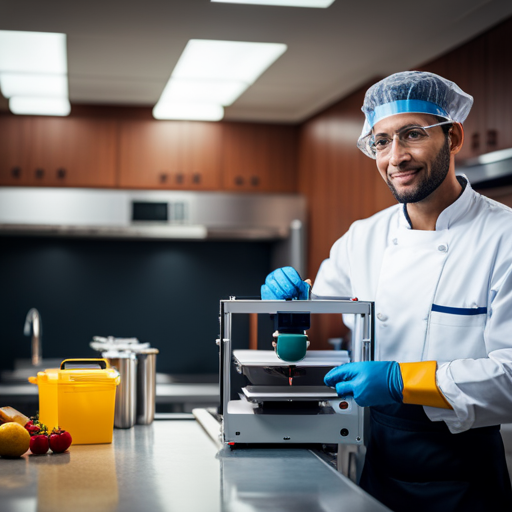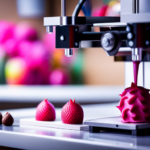In the rapidly evolving landscape of food technology, the emergence of 3D printing has revolutionized the food industry.
However, the potential risks associated with food 3D printing demand a meticulous approach to safety and hygiene.
This article delves into the critical considerations and best practices for ensuring the utmost safety and hygiene in food 3D printing, addressing the importance of:
- Material selection
- Cleanliness protocols
- Regulatory compliance
- Hygienic handling and storage.
Potential Risks in Food 3D Printing
Potential risks in food 3D printing include cross-contamination, inadequate sterilization, and regulatory compliance challenges. Health hazards and contamination risks are major concerns in this emerging technology.
Cross-contamination can occur when using the same equipment to print different types of food, leading to allergen transfer or the spread of harmful bacteria. Inadequate sterilization of 3D printing equipment, such as nozzles and chambers, can also pose health risks by allowing bacteria or other pathogens to contaminate the food product.
Additionally, regulatory compliance challenges arise due to the novel nature of 3D printed food, which may not fit neatly into existing food safety regulations.
To address these risks, it is crucial to establish strict protocols for cleaning and sterilizing 3D printing equipment between uses to prevent cross-contamination. Furthermore, ensuring that the materials used in 3D printing are food-safe and compliant with regulatory standards is essential for mitigating health hazards and contamination risks.
As the technology continues to evolve, it is imperative for regulatory bodies to adapt and develop comprehensive guidelines specific to 3D printed food to safeguard public health.
Importance of Material Selection
The selection of materials for food 3D printing is a critical factor in ensuring the safety and compliance of the end products. Material compatibility and printing parameters play a crucial role in determining the suitability of a material for food 3D printing.
When choosing materials for food 3D printing, several key considerations need to be taken into account:
-
Food-Grade Certification: Ensure that the material is certified as food-grade and complies with relevant regulations and standards.
-
Thermal Stability: The material should possess the required thermal stability to withstand the printing process without degradation or release of harmful substances.
-
Hygienic Properties: Materials should be non-toxic, non-reactive, and resistant to microbial growth to maintain the hygiene of the printed food products.
-
Compatibility with Printing Equipment: Select materials that are compatible with the specific 3D printing equipment and can be effectively processed under the required printing conditions.
The careful selection of materials is essential to mitigate potential risks and ensure the safety and quality of 3D printed food products. This underscores the critical importance of material selection in food 3D printing processes.
Moving forward, it is imperative to delve into the implementation of cleanliness and sanitization protocols to further ensure the safety and hygiene of food 3D printing.
Cleanliness and Sanitization Protocols
To maintain high standards of safety and hygiene in food 3D printing, regular implementation of thorough cleanliness and sanitization protocols is imperative. Sanitization procedures are crucial in preventing the contamination of food products during the 3D printing process. All equipment used in the printing, handling, and packaging of food items must be thoroughly sanitized to eliminate any potential sources of contamination. This includes the 3D printers, printing nozzles, conveyor belts, and any other surfaces that come into contact with the food. Sanitization procedures should be in accordance with industry standards and best practices to ensure the highest level of cleanliness.
Equipment maintenance is also a key aspect of cleanliness and sanitization protocols. Regular maintenance and cleaning of the 3D printers and associated equipment are essential to prevent the buildup of food residues, bacteria, or other contaminants. This can help to prolong the lifespan of the equipment and ensure that it operates at optimal performance levels.
Moving forward, it is essential to address regulatory compliance and standards to further ensure the safety and hygiene of food 3D printing processes.
Regulatory Compliance and Standards
In the realm of 3D food printing, compliance with food safety, industry standards, and regulations plays a pivotal role in ensuring the safety and quality of printed food products.
It is essential for manufacturers and operators to adhere to the established regulatory requirements and industry standards to mitigate potential health risks and uphold consumer confidence.
This discussion will address the critical aspects of regulatory compliance and standards in the context of food 3D printing.
Compliance With Food Safety
Ensuring compliance with food safety regulations and standards is paramount in the implementation of 3D printing technology for food production. This involves meticulous attention to food handling and equipment maintenance to prevent contamination and ensure safe consumption.
Key considerations for compliance with food safety in 3D printing include:
-
Material safety: Ensuring that the materials used in 3D printing are food-grade and safe for consumption.
-
Sanitization protocols: Implementing rigorous cleaning and sanitization procedures for 3D printing equipment to prevent microbial contamination.
-
Traceability: Establishing systems to trace the sources of 3D printing materials and ingredients to ensure quality and safety.
-
Regulatory adherence: Complying with food safety regulations and standards set forth by relevant authorities to maintain high standards of safety and hygiene.
These measures are essential to guarantee the safety and quality of 3D printed food products.
Moving forward, it is crucial to delve into industry standards and regulations for a comprehensive understanding of food safety in 3D printing.
Industry Standards and Regulations
Adherence to industry standards and regulations is fundamental for ensuring regulatory compliance and standards in food 3D printing.
Industry regulations play a crucial role in establishing safety measures and protocols to mitigate potential risks associated with the production and consumption of 3D printed food.
These regulations encompass various aspects, including materials used in printing, equipment standards, labeling requirements, and hygiene practices.
Compliance with these standards is essential to guarantee the safety and quality of 3D printed food products.
Additionally, adherence to industry regulations fosters consumer trust and confidence in the technology.
It also provides a framework for manufacturers to operate within legal boundaries and aligns the industry with established food safety standards.
Best Practices for Safe Food Printing
When printing food using 3D technology, it is essential to prioritize safety and hygiene by following best practices. This ensures that the printed food is safe for consumption and meets quality standards.
The following best practices should be adhered to when 3D printing food:
-
Safe Handling: Implement strict protocols for the handling of food materials before, during, and after the printing process to prevent contamination.
-
Printing Parameters: Set and maintain optimal printing parameters such as temperature, pressure, and speed to guarantee the safety and quality of the printed food items.
-
Quality Control: Regularly inspect and test the 3D printed food products to ensure they meet safety and quality standards.
-
Cross Contamination: Implement measures to prevent cross contamination between different food materials and printed items to maintain food safety.
Adhering to these best practices is crucial for the safe production of 3D printed food items. Moreover, it is imperative to ensure that these practices are consistently followed to minimize the risk of contamination and ensure the safety and quality of the printed food. This includes ensuring hygienic handling and storage of the printed food items.
Ensuring Hygienic Handling and Storage
In ensuring hygienic handling and storage in food 3D printing, it is crucial to implement proper storage methods and hygienic handling practices. This includes maintaining appropriate temperatures, utilizing food-grade storage containers, and preventing cross-contamination.
Additionally, adherence to strict hygiene protocols for handling and storing food materials is essential to minimize the risk of contamination during the 3D printing process.
Proper Storage Methods
To ensure hygienic handling and storage in food 3D printing, meticulous attention must be paid to proper storage methods. Proper handling and temperature control are essential to prevent contamination and ensure the safety of 3D printed food products. The following measures should be implemented:
- Use airtight containers to store raw food materials and ingredients.
- Maintain proper labeling and rotation of stock to ensure the use of oldest materials first.
- Store printed food products in controlled temperature environments to prevent bacterial growth.
- Regularly clean and sanitize storage areas, including refrigerators and freezers, to prevent cross-contamination.
Hygienic Handling Practices
Adhering to stringent hygienic handling practices is imperative for ensuring the safety and quality of food 3D printing. This includes the handling and storage of raw materials and printed products.
Proper handwashing is essential to prevent the transfer of harmful bacteria and contaminants onto raw materials and printed products. All personnel involved in the food 3D printing process should adhere to proper handwashing techniques, including thorough washing with soap and water for at least 20 seconds.
Additionally, preventing cross-contamination is crucial. This involves implementing measures to avoid the transfer of pathogens from one surface to another. Examples include using separate storage areas for raw materials and printed products, as well as implementing strict cleaning and sanitation protocols for equipment and workspaces.
Frequently Asked Questions
Can Food 3D Printing Technology Be Used to Create Allergen-Free Foods?
Food 3D printing technology has the potential to create allergen-free recipes by using novel ingredients. This innovative process allows for precise control over the composition of the food, enabling the production of safe and customized options for individuals with specific dietary restrictions.
Are There Any Specific Guidelines for the Safe Handling and Disposal of Food 3D Printing Materials?
When addressing the safe handling and disposal of food 3D printing materials, it is imperative to adhere to stringent food safety regulations. This is crucial in mitigating cross-contamination risks, ensuring consumer hygiene, and meeting commercial standards.
What Are the Potential Risks of Cross-Contamination When Using a 3D Food Printer?
Cross contamination risks in 3D food printing can arise from shared printing equipment and improper handling of raw and cooked materials. Adhering to strict food safety precautions, such as separate printing areas and thorough sanitation, is crucial.
How Can Consumers Ensure the Safety and Hygiene of Food Printed at Home Using 3D Printers?
Ensuring safety and hygiene of food printed at home using 3D printers requires meticulous attention to safe storage and proper cleaning. These critical steps safeguard against potential contaminants and maintain the integrity of the printed food.
Are There Any Specific Regulations or Standards in Place for the Use of Food 3D Printing Technology in Commercial Food Production?
Regulatory compliance and industry standards for food 3D printing in commercial production are essential. These ensure product safety, quality, and consumer protection. Regulatory bodies like the FDA and EU have issued guidelines to govern this emerging technology.
Conclusion
In conclusion, ensuring safety and hygiene in food 3D printing is essential for protecting consumer health and maintaining regulatory compliance.
Just as a ship needs a sturdy anchor to stay grounded in turbulent waters, food 3D printing requires stringent protocols and material selection to anchor its safety and cleanliness.
By implementing best practices and adhering to regulatory standards, the food 3D printing industry can navigate the challenges and ensure the production of safe and hygienic printed food products.


